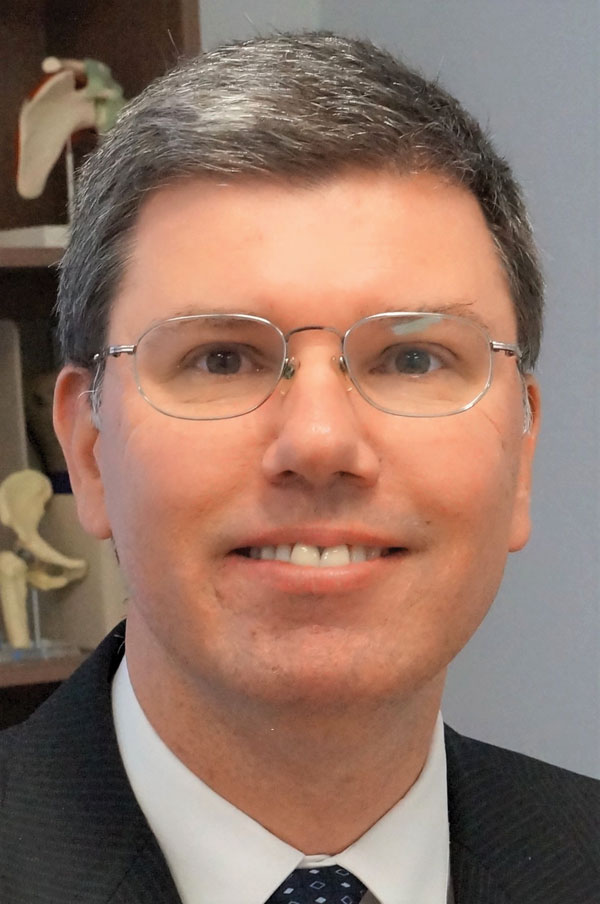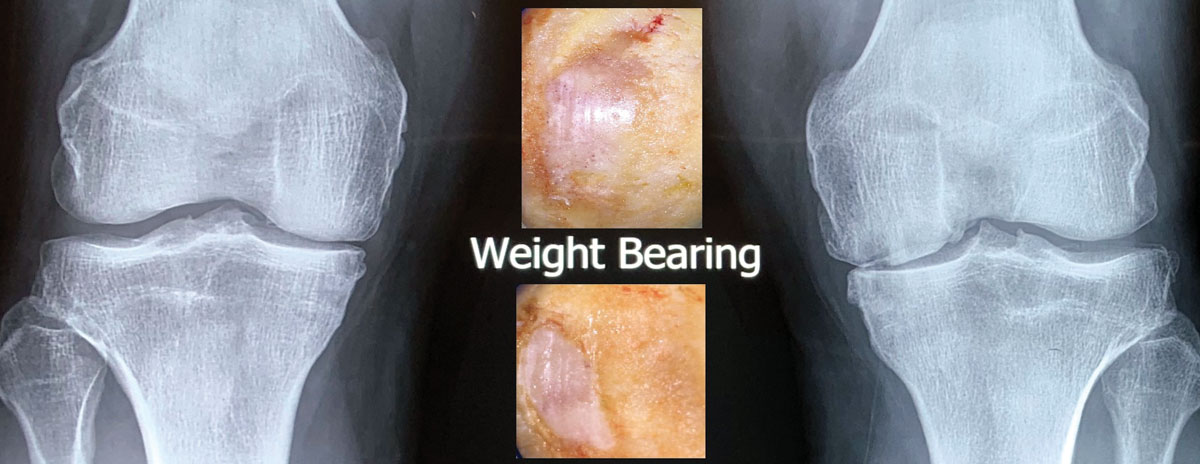
Degenerative joint disease (osteoarthritis, OA) can have no clear aetiology (‘primary’ or ‘intrinsic’) or be ‘secondary’ to another pathology (e.g. trauma, sepsis, congenital). Primary and secondary factors can both be involved with the former modifying susceptibility and the latter affecting the onset age and location of disease.
While symptoms include stiffness, loss of range, deformity, limp, weakness and functional limitation, pain is mainly why relief is sought.

OA pain from the hip commonly presents in the groin or thigh, less commonly in the buttock or knee. OA pain from the knee is more commonly localised, but the hip and spine still need to be considered as potential sources.
The pain from hip and knee OA is usually gradual onset, mechanical (i.e. movement related) and associated with other complaints, as above, that can help with localisation. Patients with hip (not knee) arthritis often have issues with footcare and footwear.
Illuminating questions focus on walking distance before stopping, use of supports (e.g. crutches or supermarket trolley) and difficulties with routine activities such as sitting in and rising from chairs.
Examination starts in the waiting room. Evaluate walking, standing, sitting and any use of walking aids. Walking pattern can reveal stiffness (short swing), pain (short stance) and weakness (e.g. Trendelenburg). When supine, passive joint movement assesses symmetry, stiffness, range and stability. Measures of joint range need not be absolute to help localise issues. Assessing leg length discrepancy, both apparent (to eye) and true (accounting for deformities) helps.

Radiology is important and doesn’t need to be invasive (e.g. arthrograms) or expensive (e.g. MRI) if the diagnosis is suspected OA. For the hip an AP pelvis and AP/lateral hip (of the affected side) provides information regarding morphology and relative leg length. If surgical referral is likely, ask for films at 120% template magnification (allows for preoperative prosthesis sizing) and centred on pubis (shows more femur). Most hip surgeons still prefer hardcopy films.
For the knee, AP weightbearing knees and lateral/skyline/notch views of the affected knee define the location and extent of degenerative changes in stance in both knees and the extent throughout the more symptomatic knee. Specific magnifications are usually not critical in initial knee radiographs.
Treatment is symptom based. Simple analgesics, appropriate use of anti-inflammatories, maintenance of low-impact mobility, minimising provoking activities, weight optimisation (where indicated) and possibly walking aids remain the mainstay of management. Don’t inject knees that aren’t going to respond to injections as this precludes implant surgery for three months.
Majority consensus is that knee arthroscopic intervention does not have a role in the management of the articular surface disease itself but may have a role in non-endstage OA joints for symptomatic (in comparison to imaging-detected) meniscal pathology and relief of locking from loose bodies.
Arthroplasty (joint replacement) is reserved for patients with conclusive OA with significant painful symptoms not ameliorated by a thorough trial of conservative measures. While joint replacement surgery may assist with mobility, gait, subjective stiffness, deformity and function, it may not, and should be viewed as a measure to relieve pain resistant to reasonable lesser measures.
Hip and knee replacements do provide good long-term relief of symptoms in the majority of patients with OA who receive them, but they are significant endstage procedures primarily for the relief of otherwise intractable pain.
Key messages:
- Hip and knee OA are common and pain the driving issue
- Radiology is important and should be focussed
- Treatment is aimed at symptomatic improvement
References available on request.
Questions? Contact the editor.
Author competing interests: None to disclose.
Disclaimer: Please note, this website is not a substitute for independent professional advice. Nothing contained in this website is intended to be used as medical advice and it is not intended to be used to diagnose, treat, cure or prevent any disease, nor should it be used for therapeutic purposes or as a substitute for your own health professional’s advice. Opinions expressed at this website do not necessarily reflect those of Medical Forum magazine. Medical Forum makes no warranties about any of the content of this website, nor any representations or undertakings about any content of any other website referred to, or accessible, through this website.

